These mint chocolate crinkle cookies are the perfect baked treat for mint chocolate lovers. These beautiful brownie-like cookies have a deep chocolate flavor with a kiss of mint.
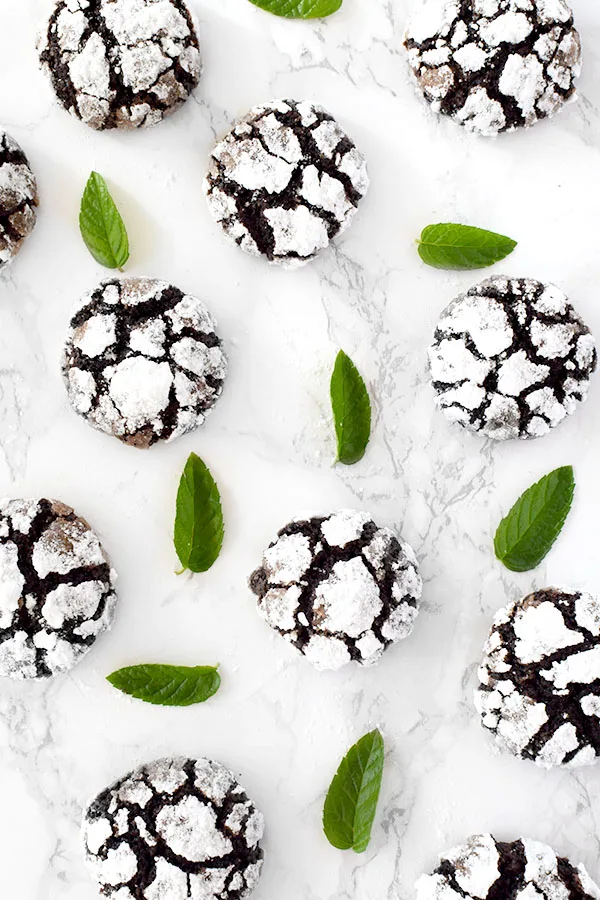
When I lived in New York, the thing I’d look forward to most every winter was the first blizzard.
I loved seeing the New York City landscape covered in the fine white powder. There was nothing like inhaling the crisp air, or sitting inside with a mug of my mother’s hot chocolate.
Mint chocolate crinkle cookies are, in my opinion, the ultimate winter cookies. Maybe even the best winter dessert.
The powdered sugar reminds me of snow, the coolness of the mint brings back the memory of the cold air, and the brownie like cookie is reminiscent of hot chocolate that warms you up from the inside out.
The one difference between these cookies and my easy chocolate crinkle cookies or my mocha crinkle cookies is that these need to be powdered really well.
These cookies have extra moisture in them, which makes the powdered sugar more likely to melt. To prevent this, coat them so well that they look like snowballs!
Also, if you can, use vanilla sugar. This is far more common in Europe than in the States. However, the lack of extra moisture really helps keep the powder sugar nice and dry.
Otherwise, you can use vanilla extract, but no more than one teaspoon, or else the cookies will be too wet.
Also, do not eat these hot. Let them cool first. When I first tried them, the mint extract made them taste like leaves… but when they cooled, they tasted incredible.
Making Cookies with Oil
Making cookies with oil is a little bit different than making cookies with butter.
When making cookies with butter, the butter is often creamed with sugar first. Cookies made with oil don't have this step, so they could require a little kneading.
Also, since butter is about 80% fat and 20% water, and oil is 100% fat, you need less oil than you do butter.
However, that could lead to cookie dough with oil being drier to work with. This is not the case with cookies like crinkle cookies, but in most cases, it is.
So, what I like to do is add back some of the water until I get a similar consistency to cookie dough made with butter.
I do this by adding a bit of water at a time and mixing it in before adding a little more until I get the right consistency. This is because I usually find adding the full amount would make the cookie dough too wet.
Do Oil Cookies Need to be chilled?
In most cases, I don't find chilling cookies made with oil necessary.
It is helpful for shaping cookies if you've made them too wet, but kneading in a little flour usually is easier to work with than chilled dough.
The one exception is for cookies you plan to cut out, like sugar cookies or gingerbread cookies.
Dough you need to roll out and cut with cookie cutters will roll out easier if chilled first.
BAKING WITH OIL
Baking with oil produces a moister and tenderer texture compared to that of baked goods made with butter.
Cakes, cupcakes, muffins, and quick breads also tend to bake up taller with a better crumb and stay moist and tender much longer than recipes made with butter.
Also, since oil weighs less than butter, baked goods made with oil have a lighter texture than those made with butter.
In addition, butter is usually only 80% fat, whereas oil is 100% fat. As a result, the water that's present in butter strengthens the gluten in the flour, making it more dense and less tender than baked goods made with oil.
Oil is often used in recipes where a lighter and airier texture is desired or in recipes that call for both oil and butter, in order to have the benefits of oil while keeping the butter flavor.
Which Type Of Oil to Use
I use neutral oils like canola oil, safflower oil, and vegetable oil. You can also use stronger oils like olive oil and coconut oil, but they may change the taste somewhat.
Is it better to use canola oil or olive oil?
Canola oil is relatively cheap and, due to its lack of flavor and high smoke point, is very versatile.
Olive oil, on the other hand, is healthier. Also, its stronger flavor makes it preferable in recipes such as focaccia, which require its distinct taste.
Baking with Oil Conversion Chart
If you want to convert your butter recipes to oil recipes, take a look at my baking with oil - butter to oil conversion chart.
How to store Oil
Store oils in a cool, dark place to prevent them from becoming rancid.
If refrigerated, some oils, like olive oil, may solidify, but will return to a liquid state at room temperature.
Coconut oil begins to solidify in temperatures under 76ºF or 25ºC.
HOW TO MEASURE FLOUR AND OTHER DRY INGREDIENTS
The best way to measure dry ingredients is with a scale. However, this is not commonly done in the United States, where dry measuring cups are used instead.
To measure most dry ingredients, first spoon them into a dry measuring cup and then level off the measuring cup with an upside-down butter knife.
Make sure not to pack it down because it can lead to using more of the ingredient than called for.
The exception is brown sugar. To measure brown sugar, pack it into the measuring cup and then level off any excess.
To measure chocolate chips, nuts, or dried fruit, just pour them in and then level them off.
DRY VS LIQUID MEASURING CUP
Dry measuring cups are a set of cups that often come with measuring spoons. Each cup is a different measurement just like each spoon is a different measurement.
Liquid measuring cups, on the other hand, are cups that have measuring lines on the side to mark the measurements.
The problem with using liquid measuring cups to measure dry ingredients (like flour and cocoa) is that they are powders. So, as you shake the cup to level them off, the powders settle and you end up with more than you need.
I tested this with a friend who didn't believe me and we ended up with a number of tablespoons more than the recipe called for.
WHY sift Powdery Ingredients
There are a number of benefits to sifting powdery ingredients like flour and cocoa.
First of all, flour is often sifted before use to aerate it and remove any lumps. This helps in achieving a lighter texture in baked goods.
Secondly, if you measure flour that's just been sifted, you can get a more accurate measurement than from flour that's been packed tightly in a bag.
In addition, sifting dry ingredients together, such as flour, cocoa, and baking powder, helps make sure they're evenly dispersed.
Cocoa
Cocoa adds a rich chocolate flavor and a nice brown color to recipes. It also helps balance sweetness in recipes, adds moisture to baked goods, and can be used to decorate food.
It's used to make recipes like brownies, chocolate cake, chocolate sauce, chocolate cookies, chocolate muffins, and chocolate cupcakes. Cocoa can also be found in surprising places like cinnamon babka (just for the purpose of coloring) and savory dishes, such as chili and mole sauces.
The color can vary depending on the type of cocoa used. Natural cocoa powder tends to create a lighter color, while Dutch-processed cocoa results in a darker one.
Cocoa also adds moisture to recipes, giving baked goods a softer and tenderer texture.
Also, when combined with baking soda, cocoa's acidity activates the leavening agent, contributing to the rise and lightness of baked goods.
Furthermore, cocoa is often used for decorative purposes. It is dusted on top of cakes, used as a coating for truffles, sprinkled over whipped cream, and to create a dusted effect for plated desserts.
WHICH TYPE OF COCOA TO USE
When a recipe calls for cocoa, always use unsweetened cocoa powder, unless specified otherwise.
This allows you to have better control of the sweetness of what you’re making.
There are three basic forms of unsweetened cocoa powder: natural cocoa powder, dutch-processed cocoa power, and raw cocoa powder.
NATURAL COCOA POWDER
Natural cocoa powder comes from cocoa beans that are fermented, roasted, processed at a higher heat, and milled into a powder.
It’s bitter with a very strong and concentrated chocolate flavor.
This cocoa powder is acidic and is often used in recipes calling for baking soda because the two react with each other to allow your baked good to rise.
This is most commonly used, and should be used, in recipes that simply say "cocoa powder."
DUTCH-PROCESSED COCOA POWDER
Dutch-processed cocoa powder starts with cocoa beans that have been washed in potassium carbonate, which neutralizes their acidity.
Since Dutch-processed cocoa powder is neutral, it does not react with baking soda.
When baking, Dutch-processed cocoa is often paired with baking powder.
Dutch-processed cocoa powder can also be used in place of natural cocoa powder in recipes that don’t require leavening.
These include sauces, hot cocoa, frostings, ice cream, pudding, etc.
If you only have Dutch-processed cocoa powder on hand, you can substitute it for neutral cocoa powder.
Just make sure to add ⅛ teaspoon of cream of tartar, white vinegar, or lemon juice for every 3 tablespoons of cocoa powder called for in the recipe.
RAW CACAO POWDER
Raw cacao powder is different from natural and Dutch-processed unsweetened cocoa powder.
It's pure powder from the cacao bean and isn't nearly as processed as either natural or Dutch-processed.
Cocoa is processed at high heat, which destroys much of the nutritional benefits of the cacao seed.
Also, cocoa powder is often alkalized during processing to reduce acidity. The result is a product that’s less bitter and more soluble when added to liquids.
Cacao powder, on the other hand, is made of fermented - not roasted - seeds that are processed at low temperatures and then milled into a powder, ensuring that its nutritional benefits and its bitter flavor are preserved.
You can use raw cacao powder in recipes that don’t specify Dutch-processed cocoa powder, however it is best not to try to.
Compared to cocoa powder, cacao powder has a stronger flavor, it is not as absorbent as cocoa powder, and it is more acidic, so it will react differently with baking soda.
Sweetened Cocoa
Sweetened cocoa contains sugar and is suitable as a hot chocolate mix, but not suitable for recipes.
What's the difference between cocoa powder and cacao powder?
Cocoa powder is made by roasting cacao beans and processing them at high heat.
Cacao powder is made by cold-pressing unroasted cacao beans. It's often considered more "raw" and retains more nutrients.
Both can be used interchangeably in recipes.
Can I use Dutch-processed cocoa instead of natural cocoa?
Yes, but it can affect the acidity and leavening in the recipe. Adjustments may be needed for baking powder or baking soda.
To do this, simply add ⅛ teaspoon of cream of tartar, white vinegar, or lemon juice for every 3 tablespoons of cocoa powder called for in the recipe.
Can I use sweetened cocoa mix instead of unsweetened cocoa in baking?
No, because sweetened cocoa mix contains sugar. The added sugar can alter the sweetness and moisture of the recipe.
How to substitute chocolate with cocoa powder in recipes
How you substitute chocolate with cocoa powder depends on the type of chocolate that is called for. Mix the ingredients together in a bowl first before adding them to the rest of the recipe.
Cocoa substitute for sweet baking chocolate
To replace 4 ounces of sweet baking chocolate, use ¼ cup unsweetened cocoa powder plus ⅓ cup sugar and 3 tablespoons oil or shortening.
Cocoa substitute for semisweet and bittersweet baking chocolate
To replace 4 ounces of semisweet and bittersweet chocolate, use ¼ cup unsweetened cocoa powder plus 2 ½ tablespoons sugar and 3 tablespoons oil or shortening.
Cocoa substitute for unsweetened baking chocolate
To replace 4 ounces of unsweetened chocolate, use ¼ cup unsweetened cocoa powder plus and 3 tablespoons oil or shortening.
How do I prevent lumps when using cocoa in recipes?
Sift the cocoa into the bowl to remove lumps.
How to Store Cocoa
Store cocoa in an airtight container and keep in a cool, dark place to prevent moisture absorption and maintain flavor.
Sugar
The primary role of sugar is to be a sweetener. However, sugar also contributes to the tenderness and moistness of the baked good by absorbing and retaining moisture and helps create the golden brown color when baking as it caramelizes.
Recipes with more sugar often result in softer, moister textures. However, I learned the hard way that too much sugar leads to a sticky mess.
When it's heated, sugar caramelizes, resulting in a rich, complex flavor and a brown color. This adds both flavor and color to baked goods and is also the process in which caramel sauce, dulce de leche, caramel candies, and regular candies are made.
When used in recipes containing yeast, the sugar is eaten by the yeast, producing carbon dioxide and causing the dough to rise.
Sugar also acts as a preservative in jams, jellies, and fruit preserves by reducing water activity and preventing microbial growth.
There are many different types of sugar, including white sugar, brown sugar, vanilla sugar, powdered sugar, turbinado sugar, and demerara sugar.
When a recipe calls for “sugar” without specifying anything else, it's referring to regular white sugar.
White Sugar
White sugar (sometimes called granulated sugar, table sugar, or white granulated sugar) is made of either beet sugar or cane sugar, which has undergone a refining process.
It is the easiest to find and most commonly used.
Brown Sugar
Brown sugar is white sugar with molasses added to it.
It is commonly used in chocolate chip cookie recipes, and it’s rare for a recipe that calls for brown sugar not to also call for white sugar as well.
When a recipe calls for “brown sugar” but doesn’t specify what type (light or dark), it is referring to light brown sugar.
In my recipes, you can use whatever type of brown sugar you have on hand, whether it is dark brown sugar, light brown sugar, or demerara sugar - which is very common in Israel.
Just keep in mind that the flavor and color will be slightly different, depending on what you choose to use.
Turbinado Sugar
Turbinado sugar is better known as "raw sugar." But, despite this name, the sugar is not really “raw.”
Instead, it's partially refined sugar that retains some of the original molasses.
The term "raw sugar" may also give off the impression that it is somehow healthier.
In reality, turbinado sugar is nutritionally similar to white sugar.
Demerara Sugar
Demerara sugar is very popular in Israel and is especially delicious in tea, but is also used for baking.
Unlike white sugar, demerara sugar undergoes minimal processing and retains some vitamins and minerals.
However, it is still not much healthier than white sugar.
Vanilla Sugar
Vanilla sugar is not very common in the States. However, it is common in Israel and parts of Europe.
This is sugar that sat for an extended period of time with vanilla beans, giving it a vanilla flavor.
Caster Sugar
This type of sugar is common in the United Kingdom.
It has a grain finer than white (granulated) sugar and larger than powdered sugar.
Caster sugar is often called for in recipes for delicate baked goods like meringues, souffles, and sponge cakes.
You can use a 1:1 conversion rate between caster sugar and white (granulated) sugar.
Powdered sugar
Powdered sugar, sometimes known as confectioners’ sugar, is a sugar with a powdered texture.
This sugar is rarely used for baking. Instead, it is used for dusting desserts and making frosting, icing, and glazes.
In some countries, you can also find powdered vanilla sugar.
It is made the exact same way regular vanilla sugar is made. However, the sugar used is powdered instead of granulated.
Vanilla Extract vs Vanilla sugar
In my recipes, I don’t specify what kind of vanilla to use.
The reason for this is that in the States, vanilla extract is exclusively used.
Meanwhile in Israel, along with many European countries, vanilla sugar is common.
In most, if not all recipes, both vanilla extract and vanilla sugar can be used.
In recipes where vanilla sugar can be used instead of extract, you can replace them 1:1.
Replacing Sugar with Honey
If you’d prefer to use honey instead of sugar, you can do so with pretty good results.
Honey can be two or even three times as sweet depending on the honey, so for every 1 cup of sugar, you can use ½ to ⅔ cup honey.
Since honey adds liquid, you need to remove some to balance it out. For every cup of honey, remove a ¼ cup of liquid.
Also, it burns faster than granulated sugar, so you want to lower the baking temperature by 25 F. In addition, check it early and often to avoid burning or overbaking.
How to Store Sugar
Sugar should be stored in an airtight container to prevent clumping and moisture absorption, and kept in a cool, dry place.
BROWN SUGAR
What we call brown sugar is essentially white sugar that has had molasses added back to it.
It should not be confused with raw sugar or demerara, which are their own types of sugar.
You can easily substitute brown sugar or even make brown sugar.
Both dark and light brown sugar can easily be made at home if you have a little white sugar and molasses.
It is commonly used in chocolate chip cookie recipes, and it’s rare for a recipe that calls for brown sugar not to also call for white sugar as well.
When a recipe calls for “brown sugar” but doesn’t specify what type (light or dark), it is referring to light brown sugar.
DARK BROWN SUGAR
Dark brown sugar can be made with 1 cup white granulated sugar and 2 tablespoons molasses.
Add both ingredients into a bowl and mix with a fork until completely mixed.
LIGHT BROWN SUGAR
Light brown sugar can be made with 1 cup white granulated sugar and 1 tablespoon molasses.
Add both ingredients into a bowl and mix with a fork until completely mixed.
DEMERARA
Demerara is popular in Israel and is easier to find than light brown sugar. It is a type of cane sugar with a nice toffee flavor and can be used in place of brown sugar.
HOW TO SUBSTITUTE DARK AND LIGHT BROWN SUGAR
DARK BROWN SUGAR
Dark Brown Sugar can be made with 1 cup of light brown sugar and 1 tablespoon molasses.
Add both ingredients into a bowl and mix with a fork until completely mixed.
LIGHT BROWN SUGAR
Light Brown sugar can easily be replaced in a recipe with half dark brown sugar and half white granulated sugar.
DOES THE TYPE OF BROWN SUGAR YOU USE REALLY MATTER?
Using the wrong brown sugar will change the flavor and likely the color.
Dark brown sugar has more molasses, which will give it a deeper, more complex flavor that’s closer to toffee or caramel.
Light brown sugar is more subtle, which is sometimes ideal.
However, I tend to use what's on hand, which for me means dark brown sugar in Israel and light brown in the States.
I also happen to love the extra flavor dark brown sugar gives, so I like using it even if I have both on hand.
How to Store Brown Sugar
Store brown sugar in an airtight container to maintain its moisture and prevent it from hardening.
BAKING SODA VS BAKING POWDER
Both baking soda and baking powder are leavening agents, which means that they help baked goods rise. However, they're not the same thing and they are not interchangeable.
Using baking soda instead of baking powder can give your recipe a terrible metallic taste, while using baking powder instead of baking soda leaves your baked goods looking flat.
BAKING SODA
When baking soda (also known as sodium bicarbonate) is combined with acidic ingredients and exposed to heat, it causes batter or dough rise and contributes to their light and fluffy texture.
However, baking soda is a versatile ingredient. It can be sprinkled over meat to tenderize it and it can be added to tomato sauce to neutralize the acidity.
Baking soda, when combined with an acid - such as cream of tartar, lemon juice, buttermilk, cocoa, and vinegar - creates carbon dioxide. When the carbon dioxide is released, it causes the familiar texture and crumb in pancakes, cakes, quick breads, soda bread, and other baked and fried foods.
A good rule of thumb is to use around ¼ teaspoon of baking soda per 1 cup of flour.
BAKING POWDER
Baking powder is created by combining baking soda, cream of tartar, and sometimes cornstarch.
Since baking powder already contains an acid, it's most often used when a recipe does not call for an additional acidic ingredient or calls for too little of one.
There are two types of baking powder. Single-acting baking powder and double-acting baking power.
Single-acting baking powder gets activated only once - when it gets wet.
Most baking powder sold is double-acting. This means that the leavening occurs in two steps.
The first is when the baking powder gets wet, which is why you cannot prepare some batters ahead of time to bake later. The second step is when the baking powder is exposed to heat, which happens when the batter is baked or fried.
A good rule of thumb is to use around 1 teaspoon of baking powder per 1 cup of flour.
WHY SOME RECIPES CALL FOR BOTH
Some recipes use both baking soda and baking powder because they need extra leavening that the baking soda alone cannot provide.
In these cases, baking soda provides an initial lift, while baking powder provides additional rise.
WHICH ONE IS STRONGER?
You may have already guessed the answer since baking soda is used to make baking powder and you need more baking powder per cup of flour. But I’ll tell you anyway.
Baking soda is four times stronger than baking powder.
That's why you will, more often than not, see recipes that only call for baking soda rather than recipes that only call for baking powder.
HOW LONG DO THEY LAST?
BAKING SODA
Baking soda is good indefinitely past its best by date, although it can lose potency over time.
A good rule of thumb is two years for an unopened package and six months for an opened package.
However, to be honest, I’ve used very old baking soda with good results.
BAKING POWDER
Like baking soda, baking powder is good indefinitely past its best by date, and can lose its potency over time.
For both opened and unopened, it’s ideal to use it within nine months to a year.
While storing it, make sure to keep it in a dry place and away from humidity.
HOW TO TEST IF IT’S STILL GOOD
BAKING POWDER
To test baking powder, pour 3 tablespoons of warm water into a small bowl, add ½ teaspoon of baking powder, and stir.
If the baking powder is good to use, it should fizz a little.
BAKING SODA
To test baking soda, pour 3 tablespoons of white distilled vinegar into a small bowl, add ½ teaspoon of baking soda, and stir.
The mixture should rapidly bubble if the soda is fresh.
GLUTEN FREE OPTION
Gluten Free Flour
Substitute all-purpose gluten-free flour in place of all-purpose regular flour cup for cup.
BUCKWHEAT FLOUR
Buckwheat flour is easy to find compared to most other gluten-free flours, and it adds a nice earthy nutty taste.
The downside is that it has a distinct flavor, so the change will be noticeable.
It’s also darker, so the color won’t be the same. Substitute cup for cup.
RICE FLOUR
Rice flour can also be used and can be found in most Asian and health food stores.
White rice flour has a mild flavor and doesn’t change the color of the muffin or quick bread.
Since it doesn’t have much flavor, it's best to use it with ingredients that do. Substitute cup for cup.
OAT FLOUR
Oat flour is made from whole oats that have been ground into a powder, which can easily be done at home.
It gives more flavor and a chewier and crumblier texture than regular all-purpose flour.
Substitute 1 cup of all-purpose flour for 1 ⅓ cup oat flour. To make 1 cup of oat flour, blend 1 ¼ cups of oats in a food processor until finely ground.
Note: oats must be marked gluten-free because they can get cross-contaminated in the factory.
Baking with Humidity
Humidity can have a big impact on how your baked goods come out.
This is because when humidity is extremely high (think 70 percent or more), baking ingredients like flour, sugar, salt, baking powder, and baking soda soak up moisture from the air.
This can negatively impact the outcome of your cakes, cookies, yeast breads, and quick breads.
There are some things you can do to try to save your baking.
Try to counterbalance the additional moisture
To help counterbalance the additional moisture your dry ingredients soak up from the air, try reducing the amount of liquid in the recipe by about one quarter.
If the batter or dough looks too dry once all the ingredients are mixed together, add additional liquid a tablespoon at a time until you have the desired consistency.
This is not usually possible to do for cookies, but it does work for cakes and breads.
Store Ingredients in the Fridge
If flour and sugar are stored in the refrigerator or freezer rather than in a cupboard or pantry, they are better protected from humidity.
As an added benefit, keeping these ingredients cool also helps keep them fresher longer, in addition to helping them stay bug-free.
For the best results, let them warm to room temperature before using.
Bake for Longer
If you bake your goodies for a few extra minutes, it can help the liquid to cook off.
To avoid overbaking, continue testing for doneness every couple of minutes for breads, quick breads, cakes, cupcakes, and muffins. Cookies, on the other hand, need to be checked every minute.
Use Air Conditioning
To help lower humidity levels on humid summer days, air condition the room for at least an hour before you start baking.
Cooler air isn’t able to hold as much moisture as warm air.
Store your baked goods in an airtight container
Humidity can also ruin your fresh-baked goods because when they are left out, they can absorb moisture.
To avoid this, store them in an airtight container or resealable bag.
Adjusting for a Convection Oven
Convection ovens blow the hot air around, producing around 25 to 30 percent more heat.
Since convection ovens produce more heat, you need either lowering the temperature or shortening the cooking time to compensate.
When recipes specify temperatures and cooking times, it’s for conventional ovens, unless specified otherwise.
A simple rule to follow is to lower the temperature by 25ºF or 14ºC when baking cookies and pies, and 50ºF or 28ºC when roasting meat and poultry. Some convection ovens offer separate settings for baking and for roasting.
You can also leave the temperature the same and instead, shorten the cooking time by 25 percent. For example, if your recipe calls for 60 minutes in the oven, check the food after 45 minutes instead.
However, keep in mind, some convection ovens actually make a heat adjustment for you. That is, if you set a convection oven for 350ºF, it might actually set itself to 325ºF to compensate. So, check your manual before making adjustments.
TROUBLESHOOTING
WHY IS IT TAKING LONGER THAN DESCRIBED TO BAKE?
Over time, the thermostat on ovens gets a little off, causing some ovens to run hot and others to run cool. This is why recipes tend to say things like “10 to 15 minutes or until golden brown.” So, if it takes you longer than expected, that’s fine, don’t worry about it. Just keep baking until ready.
WHY DID MY RECIPE COME OUT TOO DRY?
Just like some ovens run cool, others run hot. If your oven runs hot, bake these at a lower temperature. Ideally, you should get an oven thermometer to know what temperature you’re really baking at.
HOW TO STORE COOKIES
Let cookies cool completely. Place in a resealable bag or an airtight container. Store at room temperature for up to a week.
HOW TO FREEZE COOKIES
Let cookies cool completely. It is best to freeze cookies on a tray so that they freeze as individuals. Then, move to a resealable freezer bag.
If this is not practical for you, place cooled cookies in a resealable freezer bag and freeze that way.
Cookies will keep for up to 3 months. After that, the quality begins to degrade.
When thawing baked cookies, remove from bag and let sit at room temperature.
If desired, you can gently reheat thawed cookies to mimic that fresh-baked taste and texture: place them in a 275°F or 135°C oven until soft.
Recipe TIP
I bake these cookies on the middle shelf and only use that shelf instead of a couple at a time. I’ve gotten good results this way.
Mint Chocolate Crinkle Cookies
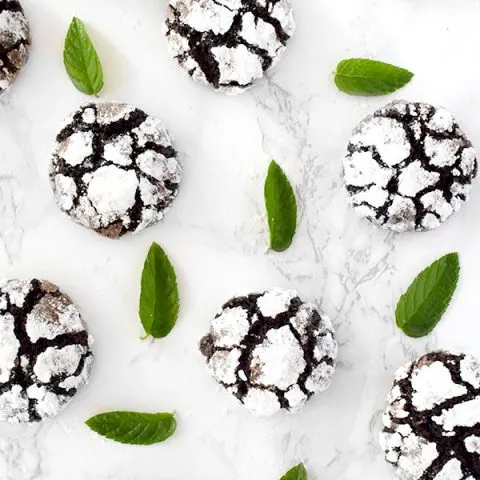
Chocolate mint flavor in a beautiful crinkle cookie.
Ingredients
- 1 cups all-purpose flour (130 grams)
- ½ cup unsweetened cocoa powder (50 grams)
- ½ cups brown sugar, packed (100 grams)
- ¼ cup white sugar (50 grams)
- 1 teaspoon baking powder
- ¼ teaspoon baking soda
- ½ teaspoon salt
- 2 eggs
- ¼ cup oil (60 milliliters)
- 2 teaspoon vanilla sugar or 1 teaspoon vanilla extract
- 2 teaspoons mint extract
For rolling
- ½ cup white sugar (100 grams)
- ½ cup powdered sugar (65 grams)
Instructions
- Whisk together flour, cocoa, brown sugar, granulated sugar, baking powder, baking soda, and salt in a mixing bowl.
- Add eggs, vegetable oil, vanilla, and mint extract. Mix with your hands until well combined. (At first, it will seem like there isn’t enough liquid and that the mixture is dry and grainy. This is fine. Keep mixing until you see the mixture develop into dough.)
- Form dough into about 1 inch or 2.5 centimeters size balls.
- Roll each ball well in the granulated sugar. Then, roll each ball very generously in powdered sugar.
- Place the balls on a baking sheet lined with parchment paper. Add more powdered sugar on top of each ball.
- Preheat the oven to 325°F or 160°C . Bake for 10 to 12 minutes.
- Remove from oven and let cool for 5 minutes before moving to a cooling rack.
Recommended Products
Some of the links below are affiliate links, which means that if you choose to make a purchase, I will earn a small commission. This commission comes at no additional cost to you.
Nutrition Information:
Yield:
26Serving Size:
1Amount Per Serving: Calories: 82Total Fat: 3gSaturated Fat: 0gTrans Fat: 0gUnsaturated Fat: 2gCholesterol: 14mgSodium: 77mgCarbohydrates: 13gFiber: 0gSugar: 8gProtein: 1g
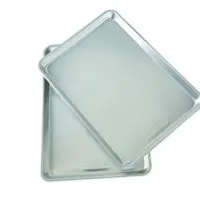
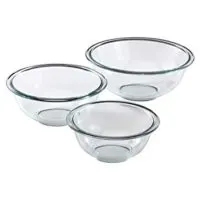
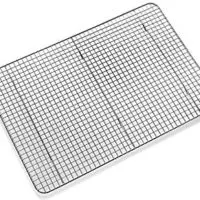
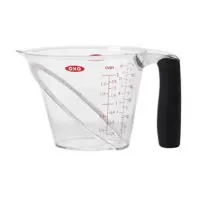
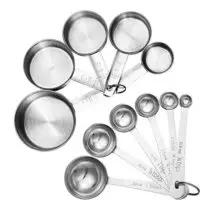
Marissa
Sunday 6th of September 2020
I LOVE this recipe!! I make it both gluten free and original. It's fantastic each time!
I've been trying to find easy dairy free recipes like this that don't try to make everything more complicated or 'healthy' so thank you!
ElissaBeth
Tuesday 8th of September 2020
I'm so happy to hear it! Almost all my recipes are dairy free and all are super easy so I hope you find more you like :)